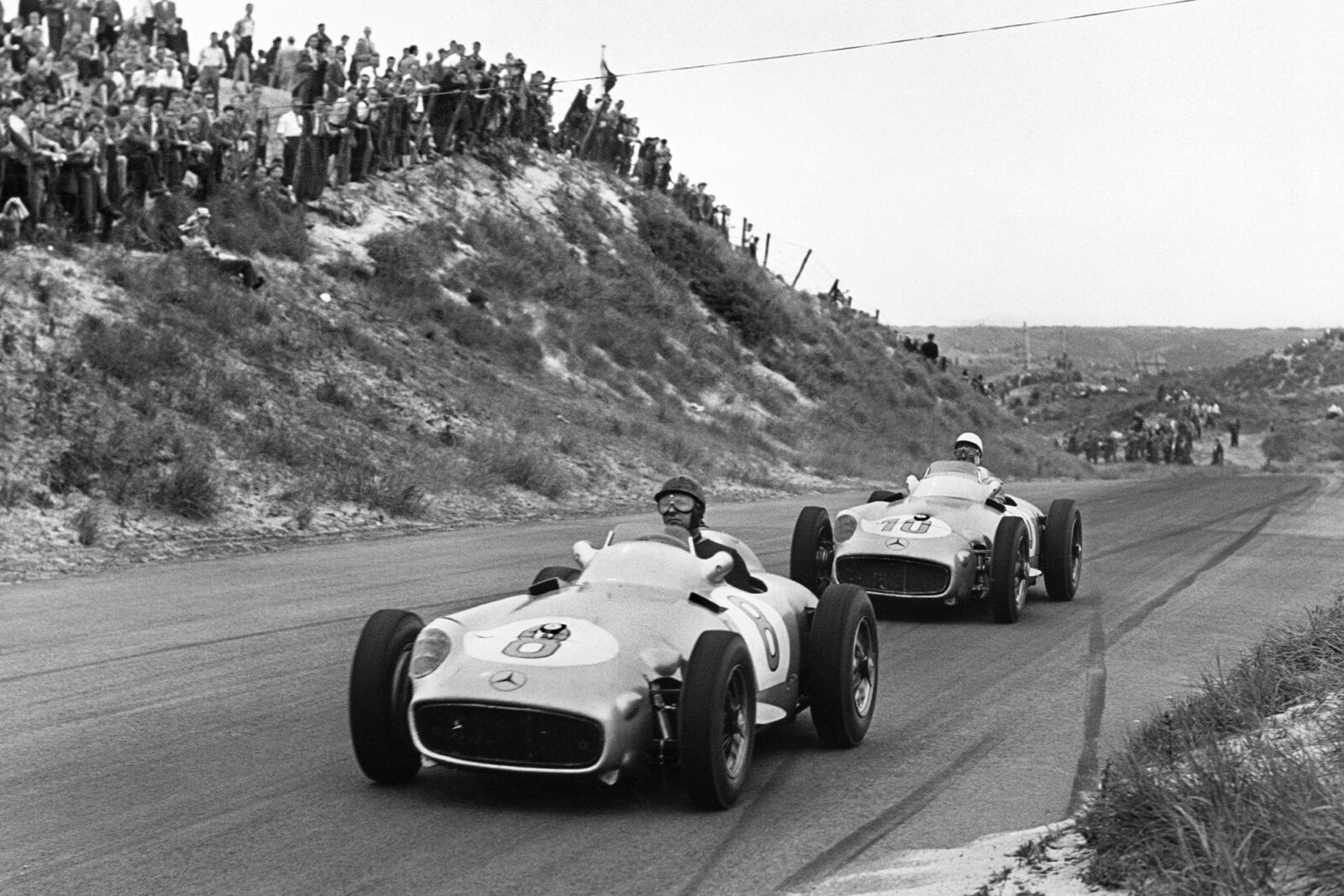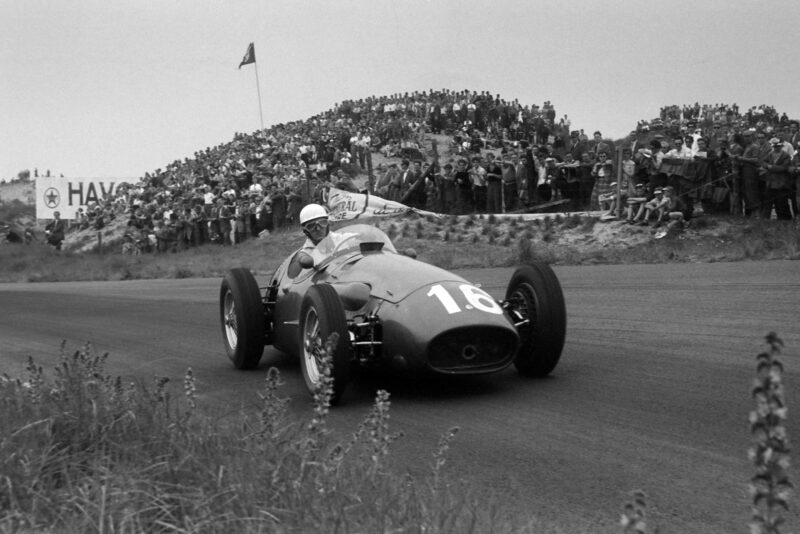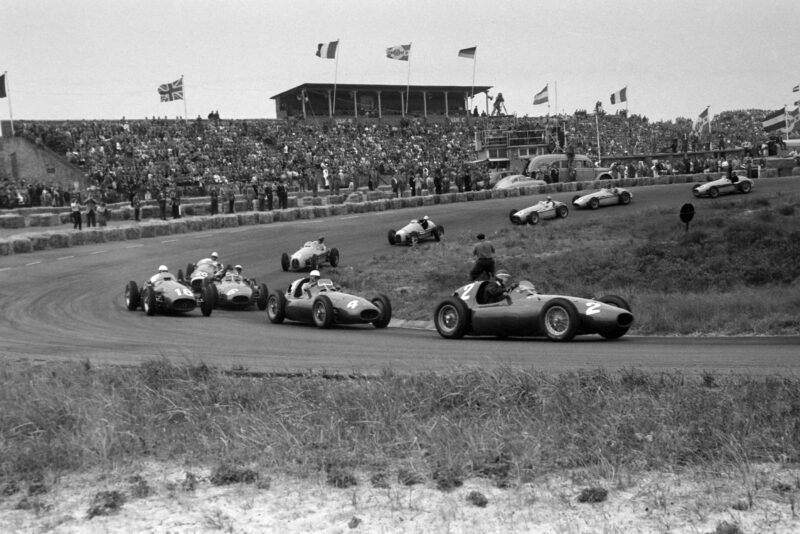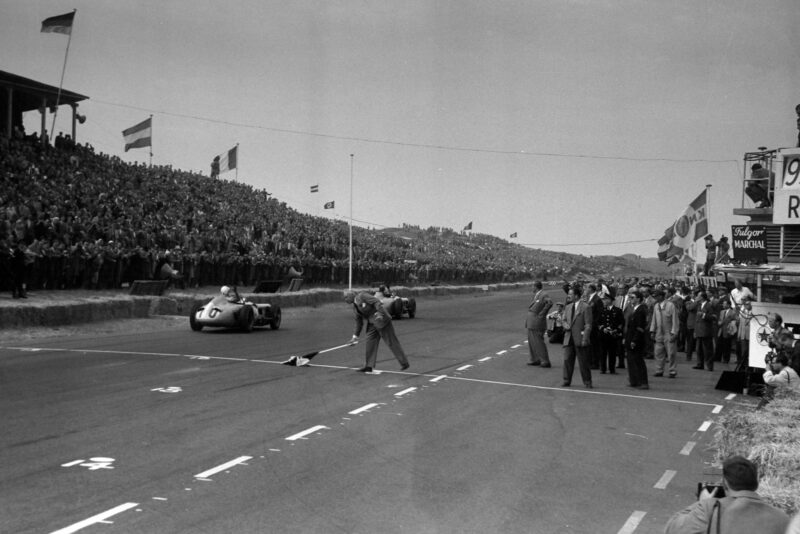1955 Dutch Grand Prix race report: Mercedes march on
Juan Manuel Fangio and Stirling Moss put on a Grand Prix masterclass to produce a second consecutive 1-2

Motorsport Images
The surface of the pleasant little 4.193-kilometre Zandvoort circuit having been put into good shape, the KNAC were permitted to organise a Grand Prix to count for the World Championship this year.
A select entry of 16 cars arrived for practice, notable withdrawals being the Lancia team and the Vanwall team, and in consequence Castellotti and Hawthorn were signed up by Ferrari, and they formed a trio with Trintignant as Farina was said to have retired. All three were using the new Tipo 555, now going very well, and they had an earlier Tipo 625 as a training car.
Mercedes-Benz were out in force, with Fangio, Moss and Kling, having an assortment of cars to choose from, there being the two types of ultra-short Monte Carlo cars and two types of medium-length cars, one with front brakes inboard and the other with them outboard.
Three factory Maseratis, unchanged from Spa, were in the hands of Behra, Mieres and Musso, while Rosier had his private car, Gould was driving Bira’s car and Walker was driving Moss’ car. Another independent was Claes, using Rosier’s old Ferrari, and the list was completed by the usual three Gordinis with Manzon, Pollet and da Silva Ramos.
Qualifying

Roberto Mieres attacks the Zandvoort circuit
Motorsport Images
Practice officially began on Friday afternoon but that morning Mercedes-Benz booked the track privately and tried out their various cars, so that after lunch they were well prepared. The Ferraris were behaving themselves, though they had the wrong axle ratios and hurriedly dismantled the rear end and changed the ratio, after which they went well. Maseratis seemed well prepared, both Mieres and Musso making good times, but Behra was content to feel his way round quietly, still suffering from his injured leg.
Gordinis just had not got enough speed, but otherwise were contented enough, Walker was enjoying himself in a real Grand Prix car for a change, while Gould was finding out that there was more to Grand Prix racing than meets the eye. It was Moss who made fastest lap with 1 min 40.4 sec, nearly 10 seconds faster than the old lap record, which was not surprising as it was held by a 2-litre Ferrari.
“No-one had any idea just how close the battle for the starting-grid had become”
The next day things did not change much, though it was Fangio’s turn to record fastest time with 1 min 40.0 sec, a speed of 150.947 kph Ferrari’s got down in the 42s and then Hawthorn did a 41.5, while the surprise of the day was Musso, who had really got the circuit weighed up and did 1 min 41.2 sec. Unfortunately there were no official times or announcements given out during practice so that no-one had any idea just how close the battle for the starting-grid had become, and the uninformed public nearly died of boredom.
Eventually it was made known that the front row of the grid was to be occupied by Fangio, Moss and Kling, all in Mercedes-Benz, with Musso and Hawthorn in row two, followed by Behra, Mieres and Trintignant, then Castellotti and Walker, and the remainder of the sixteen starters behind, but by this time practice had finished.
Race
Race day was warm and dry, with no sun, and but for a stiff breeze conditions were perfect. The start was one of the best seen for a long time and Fangio just managed to jump the flag sufficiently to get a length lead, but not sufficiently for anyone to complain, and this masterly touch put him into the lead at the first corner. Musso had followed him closely and got in front of Moss, so that the end of the first lap saw the Maserati sandwiched between the two German cars.
Afraid that Fangio would go ahead and leave him, Moss made a big effort on the swerves behind the pits, drew alongside Musso and frightened him into lifting off a fraction of a second too soon for the right-hand bend before the sharp hairpin. This let Moss through and away he went, right on Fangio’s tail. None of the Maseratis or the Ferraris could cope with these two and, lapping in 1 min 44 sec the “man and boy” proceeded to give a fine demonstration of Grand Prix driving, running round only a few feet apart.
Musso was driving splendidly, losing only a very little ground on the leaders and leaving the rest of the field far behind. Hawthorn was leading the Ferraris but was no menace to either Mercedes-Benz or Maserati teams, while Walker was leading the independents and all the Gordinis. He did this for only 2 ½ laps, for then one of the disc wheels cracked round the hub and only the ears of the hub cap stopped it coming right off. He was lucky to escape undamaged during the ensuing pirouettes.
Pollet came into his pits for a brief moment, had a shouting match with Amedee Gordini, and then drove off again in a bad temper, and after 10 laps the order was Fangio, Moss, Musso, Behra, Kling, Hawthorn, Trintignant, Castellotti, Manzon and the rest. Castellotti was not really happy in the new Ferrari and all three cars were demonstrating the most fantastic understeer round the hairpin at the back of the pits.

Hawthorn heads the pack
Motorsport Images
The two Mercedes-Benz were going steadily now at 1 min 43 sec and at lap 20 the order had not changed, though Hawthorn stopped at the pits for a moment, not satisfied with his gear-change, while Gould stopped to pour more oil into the gearbox, the casing having split. At lap 24 Kling disappeared, having spun off the road on one of the fast right-hand swerves on the back of the course, and then Gould spun on the hairpin, with a resulting pantomime while he tried to restart coasting downhill, then reversing up the course looking for somewhere to turn round. He eventually arrived back at the pits and retired, the crack in the casing losing oil too fast.
Although Moss was gaining a little ground on Fangio on the fast curves, he was losing it on the pit hairpin, being very ragged at times. He was driving a medium-length car with inboard brakes, while Fangio had the short car he drove at Monte Carlo, with the engine mounted forward; Kling had been driving the other short car that Moss used at Monaco. Round and round they went, gradually lapping the other runners, and were 17 seconds ahead of Musso at 50 laps, or half-distance, but the Italian was still driving very nicely and close enough for the Mercedes-Benz drivers not to relax or make mistakes.
“Musso was still driving very nicely and close enough for the Mercedes-Benz drivers not to relax or make mistakes”
Mieres suddenly found new life and overtook Behra, driving with great verve, and two laps later Behra stopped to complain about his rear end but soon rejoined the race. By 60 laps, however, the two Mercedes-Benz had lapped Mieres, but they still could not really get away from Musso. Then some light rain came down, making the circuit slippery, and Musso dropped back a bit, even Fangio and Moss slowing to laps of 1 min 50 sec. Trintignant broke his transmission on lap 67 and coasted in to the pits, and then the rain stopped and the track began to dry, but not completely and Musso spun on the pits’ hairpin, but, keeping his engine running, he soon carried on, losing barely 30 seconds.
By 85 laps it was all over; the two silver cars were more than a minute ahead of Musso and they just had to tour home and win. As they lapped Hawthorn yet again he tried to keep up with them, but it was not possible and for the last few laps Moss was touring round most of the way in fifth gear, but got a bit of a fright when a plug oiled up and his engine began to pop and bang on the last lap. All was well and they finished a length apart, Fangio having led from start to finish yet again.

Fangio takes the win
Motorsport Images
1955 Dutch Grand Prix race result
1. Juan Manuel Fangio (Mercedes) 2:54:23.8
2. Stirling Moss (Mercedes) + 0.3
3. Luigi Musso (Maserati) + 57.1
4. Roberto Mieres (Maserati) + 1 lap
5. Eugenio Castellotti (Ferrari) + 3 laps
6. Jean Behra (Maserati) + 3 laps
7. Mike Hawthorn (Ferrari) + 5 laps
8. Hermano da Silva Ramos (Gordini) + 8 laps
9. Louis Rosier (Maserati) + 8 laps
10. Jacques Pollet (Gordini) + 10 laps
11. Johnny Claes (Ferrari) + 12 laps
12. Maurice Trintignant (Ferrari) Retired – Gearbox
13. Robert Manzon (Gordini) Retired – Transmission
14. Horace Gould (Maserati) Retired – Accident
15. Karl Kling (Mercedes) Retired – Accident
16. Peter Walker (Maserati) Retired – Wheel bearing
Championship Standings
1. Juan Manuel Fangio – 27
2. Stirling Moss – 13
3. Maurice Trintignant – 11 1/3
4. Guiseppe Farina – 10 1/3
5. Bob Sweikert – 8
